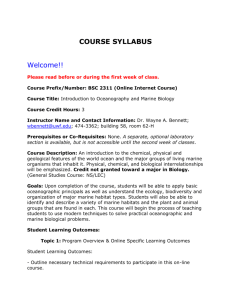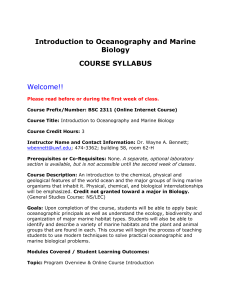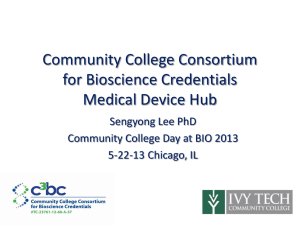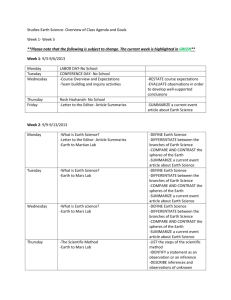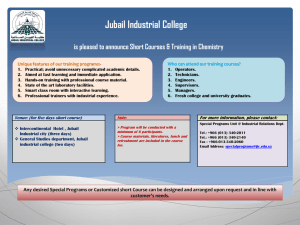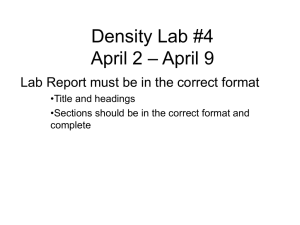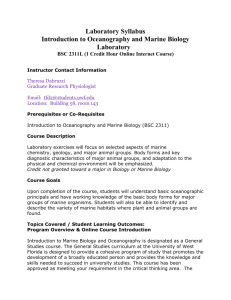Course Title: Introduction to Oceanography and Marine Biology
advertisement
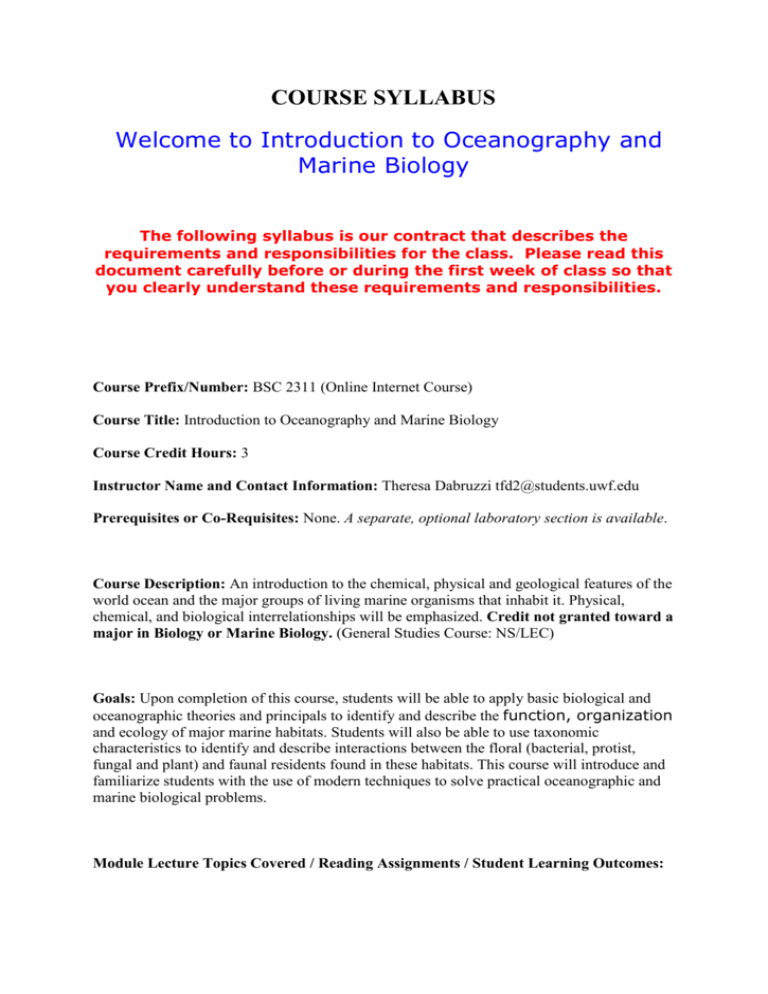
COURSE SYLLABUS Welcome to Introduction to Oceanography and Marine Biology The following syllabus is our contract that describes the requirements and responsibilities for the class. Please read this document carefully before or during the first week of class so that you clearly understand these requirements and responsibilities. Course Prefix/Number: BSC 2311 (Online Internet Course) Course Title: Introduction to Oceanography and Marine Biology Course Credit Hours: 3 Instructor Name and Contact Information: Theresa Dabruzzi tfd2@students.uwf.edu Prerequisites or Co-Requisites: None. A separate, optional laboratory section is available. Course Description: An introduction to the chemical, physical and geological features of the world ocean and the major groups of living marine organisms that inhabit it. Physical, chemical, and biological interrelationships will be emphasized. Credit not granted toward a major in Biology or Marine Biology. (General Studies Course: NS/LEC) Goals: Upon completion of this course, students will be able to apply basic biological and oceanographic theories and principals to identify and describe the function, organization and ecology of major marine habitats. Students will also be able to use taxonomic characteristics to identify and describe interactions between the floral (bacterial, protist, fungal and plant) and faunal residents found in these habitats. This course will introduce and familiarize students with the use of modern techniques to solve practical oceanographic and marine biological problems. Module Lecture Topics Covered / Reading Assignments / Student Learning Outcomes: Program Overview & Online Course Introduction Student Learning Outcomes: -Outline necessary technical requirements to participate in this on-line course. -Download and install all necessary components to participate in distance learning environment -Establish online learning environment to facilitate student interaction and engagement -Participate in asynchronous and synchronous communication learning environments. Module 1: Reading: Chapters 1-10 in “Essentials of Oceanography” (EOO) & Chapter 1 in “Introduction to Marine Biology” (IMB). Please note that while 10 chapters are covered in the EOO section of your text book, only a relatively few sections apply directly to the lecture material. The following guide will help you navigate the EOO chapters: Chapter 1- Section 1.3 Chapter 3- Sections 3.3, 3.4, 3.7, 3.9, & 3.10 - 3.13 Chapter 4- Sections 4.2, 4.6, 4.8, 4.9, & 4.11 - 4.17 Chapter 5- Sections 5.2 - 5.7, 5.9, 5.10, & 5.11 Chapters 2 and 7- 10 all discuss many fascinating topics and I encourage you to read them; however, pay particular attention to the text that relate to topics covered in the lecture. Lecture Topics and Student Learning Outcomes: The Nature of Science Student Learning Outcomes: -Define science, its goals, domain and assumptions -Identify major differences between Oceanography and Marine Biology -Describe the historical development of Oceanography and Marine Biology Geology and Geography of the Ocean Basins Student Learning Outcomes: -Identify processes that led to the formation of the World Ocean -Describe the structure of the Earth’s crust and interior -Explain the theory and mechanisms behind Plate Tectonics -Describe how continental and oceanic crusts are formed -Identify inorganic and organic sediment types that make up the ocean bottom Waves, Tides and Currents Student Learning Outcomes: -Explain the mechanisms driving atmospheric circulation -Identify major oceanic current types -Identify and describe the tidal types and mechanisms -Describe basic wave mechanics and their effects Module 2: Reading: Chapter 2 in IMB Lecture Topics and Student Learning Outcomes: The Nature of Life Student Learning Outcomes: -Identify the chemical and biological properties of life -Explain the importance and differing opinions on Spontaneous Generation -Reiterate hypotheses explaining the origin of life Concepts in Marine Ecology Student Learning Outcomes: -Identify the five major habitat types -Explain the Condition-Resource Concept -Define and give the importance of Fry's major ecological entities Evolution Revolution Student Learning Outcomes: -Explain the history of Evolutionary thought -Identify and describe specific lines of evidence for Evolution -Explain the types and importance of reproduction Module 3: Reading: Chapters 6 and 7 in IMB Lecture Topics and Student Learning Outcomes: Classification of Animals Student Learning Outcomes: -Identify and describe major historical figures that contributed to modern classification -Define and identify the five kingdoms of life -Define the phylogenetic hierarchy of life Marine Primary Producers Student Learning Outcomes: -Define primary production -Reiterate the relationship between the Kingdoms Monera, Plantae and Fungi -List major organismal characteristics of these kingdoms -Identify the major sub-groups within each kingdom and list important details of each The Marine Protists Student Learning Outcomes: -List major characteristics and ecological importance of protists -Identify and describe characteristics of the major protist groups -Identify and describe major alga types Module 4: Reading: Chapter 8 in IMB Lecture Topics and Student Learning Outcomes: The Sponges Student Learning Outcomes: -Define key characteristics of the phylum Porifera -Explain the overall morphology of sponges -Identify the ecological role of sponges The Cnidarians Student Learning Outcomes: -Define the major unique characteristics of the phylum Cnideria -Identify the general morphology and diversity of the Cnidarians -Identify the two body forms of Cnidarians -List the ecological role and importance of cniderians The Flatworms Student Learning Outcomes: -Define the major characteristics unique to the phylum Platyhelminthyes -Describe the general morphology of flatworms -List the ecological role of flatworms -Identify the symbiotic relationships of flatworms and other organisms Module 5: Reading: Chapter 9 in IMB Lecture Topics and Student Learning Outcomes: The Molluscans Student Learning Outcomes: -List the major unique characteristics of molluscs -Identify general morphological features of molluscs -Describe key features of molluscan diversity between families -Explain the ecological role of molluscs and their importance to humankind The Annelids Student Learning Outcomes: -Identify the major unique characteristics of the phylum Annelida -Explain the general morphology of Annelids -Describe the basic lifestyles used by marine annelids -List the major ecological roles of marine annelids Module 6: Reading: Chapter 9 in MB Lecture Topics and Student Learning Outcomes: The Crustaceans Student Learning Outcomes: -List the major unique crustacean characteristics -Identify the major sub-types of crustaceans and their attributes -Describe the ecological importance of crustaceans -Identify the importance of crustaceans to humans The Echinoderms Student Learning Outcomes: -Identify characteristics unique to the phylum Echinodermata -Explain the general characteristics of the echinoderm subtypes -Describe how echinoderms are important to humankind -Define the ecological importance of echinoderms The Vertebrates Student Learning Outcomes: -Identify the major characteristics of a vertebrate -List the eight major vertebrate groups -Describe the major features that have made vertebrates so successful Module 7: Reading: Chapter 10 in IMB Lecture Topics and Student Learning Outcomes The Jawless Fishes Student Learning Outcomes: -List the unique and general characteristics of the jawless fishes -List the economic and ecological importance jawless fish -Explain the reproductive tactics in this group The Elasmobranchs Student Learning Outcomes: -Identify general characteristics of the elasmobranchs -Describe the ecological role of sharks, rays and skates -Explain ways in which elasmobranchs differ from other fish groups -List 5 possible reasons for shark attacks The Bony Fishes Student Learning Outcomes: -Identify the general characteristics of the Bony fishes -Explain the general morphology of bony fishes -Give specific example of the great diversity of bony fishes -Explain the ecological and economic importance of bony fishes Module 8: Reading: Chapters 11 and 12 in IMB Lecture Topics and Student Learning Outcomes Marine Amphibians and Reptiles Student Learning Outcomes: -Identify the major, unique amphibian and reptile traits -List the three salt-tolerant frogs and describe their ecology -List the three types of marine reptiles and describe the major characteristics of each -Describe the adaptations of marine reptiles that make them suites for marine environments -Describe the ecological role of each marine reptile group and their relationship to humankind Marine Birds Student Learning Outcomes: -Identify the major characteristics of all marine birds -Identify the general characteristics of shore birds -List several characteristics of gulls and their relatives -List several characteristics of pelicans and their relatives -List several characteristics of tube-nosed birds Otters and Polar Bears Student Learning Outcomes: -Identify the general characteristics of mammals -List the defining characteristics and ecology of sea otters -Identify the major attributes of polar bears and describe how they remain warm Module 9: Reading: Chapter 12 in IMB Lecture Topics and Student Learning Outcomes: Seals and Walrus Student Learning Outcomes: -Identify the distribution and characteristics of the pinnipeds -List characteristics of the otarid and phocid seals -List characteristics of the Walrus -List characteristics of the Sirens Baleen Whales Student Learning Outcomes: -List the major trends in cetacean development -Explain the adaptations for diving in this group -Explain how this group feeds -Distinguish between the two types of Baleen whale Module 10: Reading: Chapters 12-18 Lecture Topics and Student Learning Outcomes: Toothed Whales Student Learning Outcomes: -Identify the major toothed whale characteristics -Explain echolocation -List the major characteristics of the Dolphin families -List the major characteristics of the Porpoise family -List the major characteristics of the Sperm whale -List the major characteristics of the Narwhal family Near-shore Habitats Student Learning Outcomes: -Describe the characteristics and organisms found in the Intertidal Environment -Describe the characteristics and organisms found in the Estuarine Environment Off-shore Habitats Student Learning Outcomes: -Describe the characteristics and organisms found in the Coral Reef Environment -Describe the characteristics and organisms found in the Continental Shelf Environment -Describe the characteristics and organisms found in the Open Ocean Environment -Describe the characteristics and organisms found in the Deep Sea Environment Required texts: Introduction to Marine Biology and Oceanography, A Custom Edition for the University of West Florida by Garrison, Karleskint, Turner and Small. If you have questions about the textbook, contact: Pensacola Campus Bookstore 850.474.2150 Toll-free 1.800.605.2259 Required Materials: Reliable and Consistent Internet Access E-mail Account Grading / Evaluation: Testing, weekly assignments, weekly chapter quizzes, three group power point presentations and weekly participation activities demonstrate student proficiency and expertise in the topics listed above. Students will complete activities related to the student learning outcomes. Midterm and Final Exam: The midterm and final exam in this course will be proctored. The times and location for taking the proctored exam will be announced during the first two weeks of class. Students within driving range of the University will be provided with locations and times they may take the proctored exam without additional costs. Students who cannot meet during the times or at the locations given will need to secure their own proctor. Please see the "Proctored Exam Requirement" document under the "Important Course Information" section. Please note that learning materials and exercises become accessible on Wednesday of each week, and that all materials due for that section must be received no later than midnight on the following Tuesday. No late assignments will be accepted under any circumstances. Your course grade will be determined as follows: Weekly Module Reviews: 30% Weekly Quizzes (given at the end of each section): 30% Midterm and Final Exams (together): 30% Three group power-point presentations (together): 10% Special Technology Utilized by Students: This course is totally online. All instructional content and interaction takes place over the WWW. See Topic and Student Learning Outcomes above for additional requirements. EXPECTATIONS FOR ACADEMIC CONDUCT/PLAGIARISM POLICY: Academic Conduct Policy [Web] Plagiarism Policy [ PDF] Student Handbook [ PDF] It is the philosophy of The University of West Florida that academic dishonesty is a completely unacceptable mode of conduct and will not be tolerated in any form. All persons involved in academic dishonesty will be disciplined in accordance with University regulations and procedures. Discipline may include suspension or expulsion from the University. Scholastic dishonesty includes but is not limited to cheating, plagiarism, collusion, the submission for credit of any work or materials that are attributable in whole or in part to another person, taking an examination for another person, any act designed to give unfair advantage to a student or the attempt to commit such acts. In addition, any behavior that interferes with the conduct of a class is classified as disruptive behavior and will not be tolerated. Although not exhaustive, examples of disruptive behavior would include: inappropriate or threatening online postings or emails, etc. QUALITY ASSURANCE: This course is reviewed during the semester and in an ongoing basis for quality by assessment personnel within the School of Allied Health and Life Sciences (SAHLS) to meet national standards established by the Southern Association of Colleges and Schools, the Council on Education for Public Health, and/or to address quality enhancement initiatives of SAHLS. Student feedback is also vital to this process. When reviewing our programs, our accrediting partners expect to see 100% participation in the State-of-Florida mandated SUSSAI (State University System Student Assessment of Instruction) evaluations. Thus, at the end of the semester, we need to hear from the folks that enjoyed the class and from the folks that have suggestions for improvement (ok, and from the folks that want to fill out the survey as quickly as possible with no comments to share!). BUT, we do need to hear from each and every student in this class, and we value your input. When SUSSAI evaluations are ready for you to complete, you will see a News posting in the course. Please take a few minutes to complete this anonymous, brief web-based evaluation on this course, using these directions: Step 1: Log in to Argus (http://argus.uwf.edu). Step 2: Click on the "My Info" tab. Step 3: Click the link under the category "Personal Student Record Access" that says "Instruction Assessment (Distance Learning). Need help? Contact Connie Works at (850) 474-3080 or cworks@uwf.edu for assistance! Please be assured that all evaluations that are completed online are of a confidential matter. Your name, UWF ID number, and e-mail address will not be revealed to your instructor, department, or college. Only one evaluation per course per student can be submitted. Please do not delay completing the evaluation when the time approaches. Due to the significance of this information, I will not be able to pre-release grades in eLearning if we are not close to the 100% participation goal before finals week. Thank you! ONLINE TEST TAKING GUIDELINES: Please do not begin any timed, online exam in the course that may overlap with the eLearning maintenance window. The eLearning maintenance window runs 3:00-6:00 am CST (Central Standard Time) each day. If you initiate an exam that overlaps with this time and experience any technical errors, your recorded score is likely to be close to 0 for such an attempt. There are no exceptions to this policy. If you experience any other technical problems or errors during any timed exam that does not overlap with the eLearning maintenance window, you are required to notify the Helpdesk immediately at helpdesk@uwf.edu or (850) 474-2075. Failure to contact the HelpDesk to report the problem will result in a grade of 0 automatically being assigned. If you are unable to get immediate assistance from the HelpDesk during the exam, but have documented the problem in an email or voice mail, you may attempt to restart the exam using the same browser, or attempt to re-enter the exam with another browser. If you are still unable to restart the exam and continue with saving, please note that for your final submitted score to be recorded, you MUST still prove that you documented the original technical problem with the HelpDesk via helpdesk@uwf.edu or (850) 4742075. Failure to do so will result in an automatic grade of 0 being assigned. Compliance with UWF Policies on Satisfactory Progress: If you have a question regarding the UWF policies for assignment of grades of 'W' or 'I', please visit: UWF Withdrawal Policy: http://uwf.edu/registrar/withdrawal.cfm UWF Incomplete Grade Policy: http://uwf.edu/registrar/Incomplete%20Grade%20-%20Assignment%20Report.pdf Assistance: Students with special needs who require specific examinationrelated or other course-related accommodations should contact Disabled Student Services (DSS), dss@uwf.edu, (850) 474-2387. DSS will provide the student with a letter for the instructor that will specify any recommended accommodations. Every effort will be made to accommodate the special needs of disabled students. Please inform the instructor privately during the first week of class to indicate your particular needs. All such accommodations are officially arranged through the Office for Disabled Student Services and a letter from this office must accompany your request.
